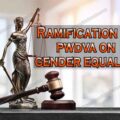
Dowry system in India is a practice where the bride’s family provides money, gifts, or property to the groom’s family during marriage. In 1961, the Indian government passed the Dowry Prohibition Act to prohibit the practice of dowry, which had become a significant social issue and a major cause of violence against women in India.
However, the law has been misused in many cases, where false dowry harassment cases are filed against the groom and his family, leading to their arrest and imprisonment. This misuse of the law has caused immense harm to innocent families and individuals and has also trivialized the issue of actual dowry harassment and violence against women.
The misuse of the Dowry law in India is attributed to several reasons, such as greed, vengeance, and false allegations. In many cases, women or their families file false dowry cases to extract money or property from the groom’s family. The misuse of the law has also been linked to the breakdown of marriages and family relationships, as the cases can drag on for years, causing emotional and financial distress to both parties.
The Supreme Court of India has been very vocal about the misuse of dowry provisions in India. In several cases, the Court has noted that the Dowry Prohibition Act, 1961, which was enacted to protect women from the harmful practice of dowry, has been misused to harass innocent individuals and families.
In one such case, the Supreme Court in Arnesh Kumar vs. State of Bihar (2014), observed that the misuse of Section 498A of the Indian Penal Code (IPC), which deals with dowry harassment, has become a tool of harassment for the husband and his family. The Court noted that in many cases, the complaints filed under Section 498A of the IPC were false and exaggerated, and were filed with the sole purpose of harassing the husband and his family.
The Supreme Court also noted that in many cases, the accused persons were arrested without proper investigation or evidence, which was a violation of their fundamental rights. The Court, therefore, directed that the police must conduct a proper investigation before making any arrests in dowry harassment cases.
In the case of Social Action Forum for Manav Adhikar and Another v Union of India Ministry of Law and Justice and Others, the Hon’ble Supreme Court of India re-examined the issue of Section 498-A of the Indian Penal Code, 1860, which was introduced to address the issue of cruelty to married women, leading to dowry deaths. However, it was found that the section was being misused by disgruntled wives as a weapon. As a result, the Court modified the previous directions issued in the case of Rajesh Sharma and others v. State of U.P. and another, which aimed to prevent misuse of Section 498-A. The Court ruled that the constitution of Family Welfare Committees and their duties are beyond the IPC and hence, impermissible. The Court directed officers investigating under Section 498-A to be guided by the principles of landmark Supreme Court judgments. The Court also ruled that only the concerned High Court has the power to quash proceedings under Section 498-A in cases which are not compoundable, and the Sessions judge has no power to do so. The Court did not interfere with the directions pertaining to Red Corner Notice, clubbing of cases, and postulating that recovery of disputed dowry items may not by itself be a ground for denial of bail. Regarding the directions on the appearance of all family members and outstation members by video conferencing, the Court directed that an application could be filed under either Section 205 or Section 317 of the Criminal Procedure Code, depending on the stage of the trial.






We need to spread awareness for this. These biased-laws are misused the most these days.